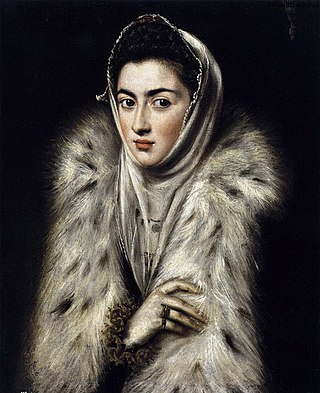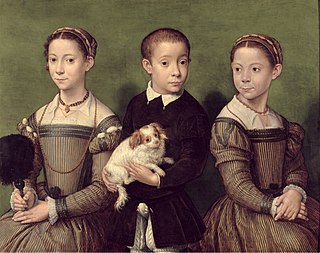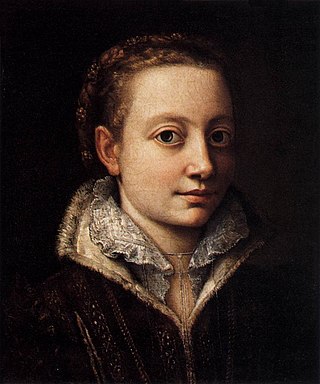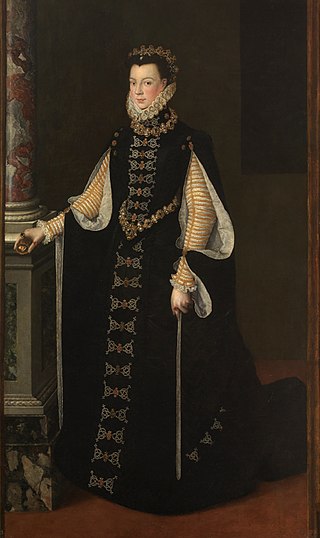
Sofonisba Anguissola, also known as Sophonisba Angussola or Sophonisba Anguisciola, was an Italian Renaissance painter born in Cremona to a relatively poor noble family. She received a well-rounded education that included the fine arts, and her apprenticeship with local painters set a precedent for women to be accepted as students of art. As a young woman, Anguissola traveled to Rome where she was introduced to Michelangelo, who immediately recognized her talent, and to Milan, where she painted the Duke of Alba. The Spanish queen, Elizabeth of Valois, was a keen amateur painter and in 1559 Anguissola was recruited to go to Madrid as her tutor, with the rank of lady-in-waiting. She later became an official court painter to the king, Philip II, and adapted her style to the more formal requirements of official portraits for the Spanish court. After the queen's death, Philip helped arrange an aristocratic marriage for her. She moved to Sicily, and later Pisa and Genoa, where she continued to practice as a leading portrait painter.

Lucia Anguissola was an Italian Mannerist painter of the late Renaissance. Born in Cremona, Italy, she was the third daughter among the seven children of Amilcare Anguissola and Bianca Ponzoni. Her father was a member of the Genoese minor nobility and encouraged his five daughters to develop artistic skills alongside their humanist education. Lucia most likely trained with her renowned eldest sister Sofonisba Anguissola. Her paintings, mainly portraits, are similar in style and technique to those of her sister. Contemporary critics considered her skill exemplary; according to seventeenth-century biographer Filippo Baldinucci, Lucia had the potential to "become a better artist than even Sofonisba" had she not died so young.

Bernadino Campi was an Italian Renaissance painter from Cremona, who worked in Reggio Emilia. He is known as one of the teachers of Sofonisba Anguissola and of Giovanni Battista Trotti. In Cremona, his extended family owned the main artistic studios. Giulio Campi and Antonio Campi, half-brothers, were distant relatives of Bernardino; the latter is generally considered the most talented of the family. All were active and prominent painters locally. Influences on Bernardino include local Cremonese such as Camillo Boccaccino and artists from neighbouring regions such as Correggio, Parmigianino and Giulio Romano. He made a number of sets of copies of the Eleven Caesars by Titian, then in the Gonzaga collection, adding one of Domitian, which he based on a work by Giulio Romano. Titian's originals were all lost in an 18th-century fire in Madrid.
Events from the year 1555 in art.
Events from the year 1550 in art.

Portrait of the Artist's Family is a 1558–59 oil-on-canvas painting by the Italian artist Sofonisba Anguissola in the Nivaagaard art gallery, in Copenhagen.

Elena Anguissola was an Italian painter and nun. She was the sister of the better-known painter Sofonisba Anguissola.

Lady in a Fur Wrap is an oil painting now generally attributed to Alonso Sánchez Coello, dated to 1577-1579 and now held at the Pollok House in Glasgow.

The Chess Game is a painting of c. 1530 by Giulio Campi, a Renaissance painter from Cremona. Since 1970, it has been in the Museo Civico d'Arte Antica in Turin.

The Portrait of Elena Anguissola, dated to 1551, is one of the earliest paintings by Sofonisba Anguissola. An oil painting on canvas, it is in the Southampton City Art Gallery, which acquired it in 1936.

The Child Bitten by A Lobster is a drawing by the Italian painter Sofonisba Anguissola, executed in chalk and pencil on light blue paper, and dated to around 1554. It is in the collection of the Museo di Capodimonte, in Naples.

The Game of Chess is an oil-on-canvas painting executed ca. 1555 by Italian Renaissance artist Sofonisba Anguissola. Anguissola was 23 years old when she painted it.

The Portrait of Juana of Austria and a Young Girl is a full-length portrait executed by the Italian sixteenth-century artist Sofonisba Anguissola. It was one of Anguissola's first paintings after arriving at the Spanish court, where she was official painter to the queen of Spain, Isabel de Valois. In a letter to the artist Bernardo Campi, she said that the painting was for the Pope, who was then Pius IV.

Anna Maria Anguissola was a 16th-century Italian painter born in Cremona, Italy.

Self-Portrait is a small oil-on-panel painting by the Italian artist Sofonisba Anguissola, signed and dated 1554 on the open book held by the artist. The portrait is now in the Kunsthistorisches Museum, in Vienna.

Portrait of Minerva Anguissola is a c. 1564 oil-on-canvas painting by the Italian painter Sofonisba Anguissola, now in the Pinacoteca di Brera in Milan.

Portrait of Elisabeth of Valois is an oil-on-canvas painting executed c.1561–1565 by the Italian artist Sofonisba Anguissola, now in the Museo del Prado in Madrid.

Portrait of Infanta Isabella Clara Eugenia is a 1599 oil-on-canvas painting of Isabella Clara Eugenia by the Italian painter Sofonisba Anguissola, identified in 1992 by Maria Kusche. Owned by the Museo del Prado, it currently hangs in the Spanish Embassy in Paris.

Portrait of Massimiliano II Stampa is a c.1558 oil-on-canvas painting by the Italian Renaissance painter Sofonisba Anguissola, now in the Walters Art Museum, Baltimore, USA. It was previously misattributed to Giovan Battista Moroni, possibly due to stylistic similarities with Moroni's The Knight in Black.
Maria Kusche was a Spanish art historian of German descent, a specialist on painters at the royal court of Philip II of Spain, in particular Sofonisba Anguissola, Juan Pantoja de la Cruz, and Alonso Sánchez Coello.
















